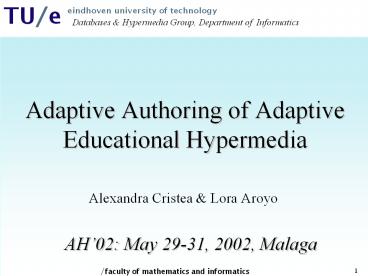Adaptive Authoring of Adaptive Educational Hypermedia - PowerPoint PPT Presentation
Title:
Adaptive Authoring of Adaptive Educational Hypermedia
Description:
... of Adaptive Educational Hypermedia. Alexandra Cristea & Lora Aroyo. Databases & Hypermedia Group, Department of Informatics. AH'02: May 29-31, 2002, Malaga ... – PowerPoint PPT presentation
Number of Views:101
Avg rating:3.0/5.0
Title: Adaptive Authoring of Adaptive Educational Hypermedia
1
Adaptive Authoring of Adaptive Educational
Hypermedia
Databases Hypermedia Group, Department of
Informatics
- Alexandra Cristea Lora Aroyo
AH02 May 29-31, 2002, Malaga
2
Keywords
- Ontology
- Collaboration
- Cooperation
- Adaptivity
- Adaptability
- Web-based courseware
- ODL
C2
A2
3
Index
- Background, Motivation and Ideas
- AIMS MyET
- Concept Mapping Approach to Adaptive Authoring
- Conclusion Future research
4
Index
- Background, Motivation and Ideas
- AIMS MyET
- Concept Mapping Approach to Adaptive Authoring
- Conclusion Future research
5
Course authoring requirements
- designing course contents alternatives,
- adaptation techniques ultimately,
- whole user-interaction mechanism
- adaptive courseware authoring tools should offer
tuneable complexity automatic authoring tasks
6
Index
- Background, Motivation and Ideas
- MyET AIMS
- Concept Mapping Approach to Adaptive Authoring
- Conclusion Future research
7
General Course Structure
MyET
AIMS
8
Text presentation structure
- smallest block / object in course structure
- MyET ? text also has body obligatory attrs
- short title, keywords, explanation, patterns to
learn, conclusion exercises. (for search
retrieval) - AIMS authors select domain terminol. keywords
(CM) - which link directly to lessons (course structure
of course topics and exercises). - presentation instructional formats to map
course material both task- use-oriented
9
Lesson composition
- 1- more texts (w. multimedia or not)
- MyET, ? lesson has texts attr.s title,
keywords, explanation, conclusion, combined
exercises text obj. struct. - text/lesson is generically called
- SUBJECT in MyET or
- TOPIC consisting of course TASKS in AIMS.
10
Index
- Background, Motivation and Ideas
- AIMS MyET
- Concept Mapping Approach to Adaptive Authoring
- Conclusion Future research
11
Concept mapping
- Concepts pieces w. independent semantics
concept hierarchy
composite concepts
atomic concepts
12
Lesson map
13
Lesson Adaptation
14
Concept Editing Traditional Order
15
Concept Editing Traditional Order
- write sequential course text /- multimedia
- divide organize content into concept structure
- concept hierarchy concepts, sub-concepts
atomic c. - fill-in main concepts attr.s (name, content,
etc.) - add adaptive features
- rule-base, importance coefficients, weights,
- generating lesson map/sequence
- define items to display conditions
- generate new attributes
- return to 3 for refined granulation
- create lesson maps
16
Non-traditional authoring Direct Concept editing
- write concepts concept hierarchy
- define concept attributes (define main extra
attr.s) - fill-in concept attributes (write contents)
- add content related adaptive features regarding
UM (design alternatives, conditions) - define format (presentation means-related
chapters) - add adaptive features regarding presentation
means (define pages)
17
Resulting layers
18
1st layer conceptual layer
- atomic concepts sub-layer (cannot be changed
anymore) - Adaptation automatization here are, e.g.,
search of related (identical?) concepts, to warn
author that new concept s/he wants to define ?.
Automatic concept connection can be done
(computed by system via heuristics approved by
author) - composite concepts sub-layer ( sets of concepts
of atomic granulation or larger w. hierarchical
structure) - Course designers/system can change hierarchy.
Here, relatedness connections also appear. System
can perform concept sub-c. adaptation, suggest
relevant higher concept classes, etc.
19
2nd layer lessons
- hierarchy of chapters, sub-chapters directed
graph - way order in which concepts should be taught.
- Note lesson layer deals w. concept attr.s, not
necessarily directly w.concepts. - system searches for alternative ? orders
20
3rd layer
- (UM - based) adaptation engine sub-layer
specifies what should be presented when
(conditions sets). - presentation means adaptation sub-layer
formatting info to appear nicely in page - ideal pg length where chapters should be cut to
form pages - how where multimedia presentations should
appear - colors, fonts, etc.
- in simplest authoring version, (2) should be
automatic
21
Index
- Background, Motivation and Ideas
- AIMS MyET
- Concept Mapping Approach to Adaptive Authoring
- Conclusion Future research
22
Conclusion
- obtained from analysis tests of MyET AIMS a
concept-based, layered architecture for AH
stratified hypermedia structure for info
disclosure - showed that due to AH authoring complexity, only
solution adaptive authoring for ALE - gave course structure CM authoring procedure
- showed in what layers adaptation should work how
23
Future directions
- next to adaptation support for content
organization presentation, author info analysis
monitoring input support tools are needed - support for info search retrieval, info
visualisation (diff. perspectives), selecting,
restructuring, annotating information w.
metadata, generation of adaptive user feedback
user preferences info. - for maintainable course content statistical
analyses - this paper sets basis of important step towards
maturity of AS towards standardization-based
authoring

